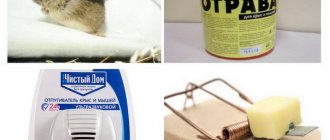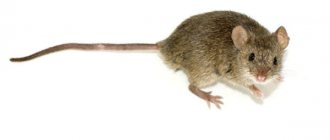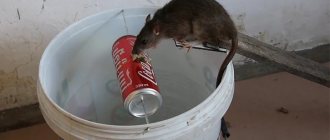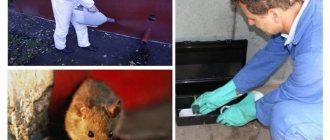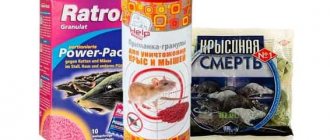How to get rid of mice in the attic is a very pressing question. Mice are small gray rodents that, at first glance, do not pose a danger to humans. However, this opinion is wrong, and if there are rodents in the house, then this problem must be urgently solved.
The fact is that mice, eating everything, are carriers of diseases such as hepatitis, cholera and even rabies. In addition, they carry smaller parasites - worms and fleas. So, even without touching this animal, a person can get a fatal disease by eating food that mice have chewed, or their excrement if it gets into food.
How to determine that there are mice in your house, or rather in the attic, because they are so small and hide so cleverly that it is very difficult to notice them. Firstly, they can be heard, especially at night, when street noise noticeably subsides. Secondly, when inspecting the attic, you can find the remains of paper dust. Mice love to chew and crumble paper. In the corners you can see mouse droppings - these are small black balls. And the main thing is the smell. In the room where mice have settled, a specific smell appears that cannot be confused with anything else.
If at least one trace of their presence is noticeable, this means that there will be more and more rodents every week. After all, a female mouse can give birth to 10 to 15 pups about once a month. And rodents need no more than 2 months to fully mature, then they themselves can bear offspring.
Beware of attic rats
There are many varieties of rodents. As a rule, Norway (gray) and attic (black) rats live in houses. To effectively control pests, it is advisable to determine what type of rodents are in your attic. The gray rat differs from the Norway rat in several ways.
Let's look at some of these differences.
- Size. Unlike the Norway rat, which is also known as the sewer rat or brown rat, attic rats are smaller in size and their tails are longer than their bodies. They grow up to 18 inches in length, including their tail, and weigh less than their counterparts.
- Color. Attic rats are typically black in color, while Norway rats are brown or gray. The former have a smaller body than Norway rats, and their fur is smooth. They also have large ears and pointed muzzles.
- Nesting sites. Unlike other types of rats, attic rodents are also good climbers and can create temporary nests not only underground in burrows. Outdoors, you may see these rats nesting in trees, bushes, and other dense vegetation. Indoors, the animals like to nest in the warmest places, especially attics, as roofs heat up during the day. In addition to attics, you can find them in various places in the home, including: closets, ceilings, garage, interior wall cavities, laundry room, etc. Their nesting site should provide the rodent with enough water to maintain life, so rats may take up residence in the yard , not far from the pool or water pump.
- Food preferences. Unlike other types of rats, which often prefer to eat leftover sausages, meats, and high-protein foods, attic rats have a diet similar to that of squirrels. This means they primarily eat nuts and fruits, but like other types of rats, attic rodents are omnivores. They will eat almost anything if they are hungry enough, including: ornamental plants, dog and cat food, cow, pig and chicken feed, vegetables, nuts, seeds, tree bark, insects, lizards, paper, paraffin and wax .
Water sources for attic rats include:
- bird waterers in the garden;
- holes and fistulas in the pipeline;
- condensate;
- drinking bowls for pets
- saucers that are placed under indoor plants;
- irrigation lines.
In addition, rats can chew on plastic and metal pipes to gain access to water, which can lead to the need for urgent repairs.
Method 2. Glue board
Glue board.
This budget-friendly method will also help get rid of rats and mice. You smear glue on a piece of wood - essentially, it turns out to be the same mousetrap, only not a mechanical one. You can buy a ready-made glue board. Place bait on it. The rodent comes to the smell and sticks to the board. All you have to do is throw away the board and the rat or mouse.
Pros : very budget method. In addition, you won’t get your hands dirty - you can simply throw away the board with the rodent without even touching the mouse or rat.
Cons : this method is quite cruel. Are you ready to listen to the heart-rending squeak of a rodent that has stuck its paws and fur to the board?
Signs of rats
You may not always be able to see rats as they are most active at night. However, you may notice signs of them in your home or on your property. Once you discover this, you need to take proper action as quickly as possible. One of the most obvious signs of an infestation is droppings. It is smaller in attic rats than in Norway rats. Other signs:
- you will hear characteristic sounds in the attic walls;
- stains and marks on drainpipes and walls;
- eaten fruits, vegetables and other food in the yard;
- damaged electrical wires;
- traces and marks along the walls inside the house;
- nests, scattered debris found on your property.
Once rats have taken up residence inside a home, their numbers can skyrocket. One female can give birth to five to eight cubs at a time. In regions with hot and temperate climates, rats breed year-round, and females can give birth up to three times a year.
Furry hunter
Cats and male cats originally served as domestic hunters. They were excellent at catching and repelling mice. Nowadays, the hunting instinct of many cats has not only become dulled, but disappeared. This is due to the fact that owners prefer to buy not simple, outbred animals, but cats of noble blood. Not only do they not repel rodents, but they themselves are afraid of them.
For a private home, it is best to take a simple yard cat. He will catch mice with pleasure and excitement and protect the territory entrusted to him from the invasion of rodents.
How do rodents get into the house?
Attic rats are good climbers and can nest at sufficient heights. They use tree branches to climb onto the roof and easily enter the attic if there are gaps in the wall or under the roof. Rodents can also get into your home in other ways, including:
- climb the vine;
- use power lines;
- climb on brick and concrete blocks.
Once they get to your home, all they need is a small hole to get inside. They often visit homes when searching for food or hiding from predators. Rats have many animal enemies, including snakes, birds of prey, dogs and cats, coyotes, and owls.
Why do you need to get rid of mice?
Mice almost never bite humans; they are much more interested in your home. Otherwise they are very dangerous. The main problem is that they destroy and contaminate food supplies. In addition, their dead skin flakes, fur and excrement can provoke exacerbation of respiratory diseases and allergic attacks in people, as well as eating disorders. Mice can also bring fleas into your home and damage your home's interior decoration and utility lines. And by the way, the smell of dead mice is just as unpleasant as the smell of dead rats.
Why are attic paints dangerous?
All rats can become aggressive when threatened. They can rush at a person and bite. The bite of an attic rat can be dangerous, as some carry various diseases, including fever, which can be contracted through a bite or even scratches. Symptoms of fever appear within a few days to several weeks. In some cases, a person becomes ill after the bite or scratch has healed, so it is important to know how these signs manifest themselves. These include:
- rashes;
- vomit;
- headache;
- fever;
- pain in muscles and joints.
Keep in mind that some diseases spread by rodents can be fatal if not treated promptly and properly. Rats droppings and urine can also be contagious. Therefore, homeowners should take all necessary precautions when cleaning up droppings and urine. For example, hantavirus can spread through airborne droplets, therefore, it is important to use personal protective equipment: masks, disposable clothing. You can also get sick from being bitten by fleas that once fed on rats. For example, this is how you can become infected with plague or tularemia.
Method 5. Homemade gypsum-based poison
A rat that ate poison.
Folk remedies for mice and rats include homemade poisons.
The main components are gypsum (alabaster) and flour. You can make balls out of them or just pour them into a bowl. Be sure to have water nearby. The rodents will think they have found a tasty meal and will eat the bait. Then they will drink water. Plaster of Paris that gets into the stomach of a rat or mouse will harden and cause intestinal obstruction. Because of this, the rodent will die. After this, you will have to inspect the house for dead rats and mice.
Life hack : you can make a poison, after which the dead rodent will not decompose, but will dry out, that is, mummify. Broad-spectrum antibiotics must be added to it. Their operating principle is as follows: a rat or mouse will die from the poison, and antibiotics will destroy bacteria that appear during the decomposition process. There will be no bacteria - there will be no smell. True, such antibiotics are quite expensive.
Pros : suitable for mass extermination of rats and mice. Not poisonous.
Cons : if you add antibiotics, the poison will be expensive.
Rat baits and traps
If you use the right bait, you can easily lure the pests into the trap. Attic rats do not prefer the same food as other types of rats, so it is better to use the following products and means for luring:
- dried fruits;
- nuts;
- berries;
- insects;
- peanut butter;
- snail shells.
Rats are often very wary in new places, and to lure them into a trap, simply leave it unloaded for a few days so that the rodents get used to it. Snap traps may seem like an old-fashioned way to catch rats, but they are still very effective. These traps have a metal mechanism that snaps shut, killing the rat. Each trap kills one rat, so you will need to set multiple traps to significantly reduce the rat population. There are several advantages to using such mechanisms:
- they can be used once or repeatedly;
- Possibility of use indoors and outdoors;
- no toxic materials are used in the manufacture of traps;
- if a rat is caught, you will see it immediately.
It is important to take all precautions when installing these traps in a home where children and pets live. You should also use protective equipment and antiseptics when disposing of your rat. Electronic traps are a more modern option. This is a humane and non-toxic way to control rats. The devices electrocute the rat and have many advantages:
- suitable for reusable use;
- the dead rat is not visible inside the trap body, but is easy to discard;
- when the rodent dies, the indicator lights up;
- The devices are safe to use and will not harm children or large pets.
Victor® offers a variety of electronic rat traps. These traps are easy to set up and install. The Zapper® Ultra kills pests with a shock of electricity. A flashing red light comes on when the rodent is destroyed. The trap requires 4 D-cell batteries to operate, and you can kill about 60 animals with one set of batteries. The company also offers the Zapper® Classic trap, which runs on 4 AA batteries. The device can kill up to 20 rats using one set of batteries. Victor® provides different types of sticky traps. They do not require any special approach to installation, so they are simple and easy to use. Simply place glue traps along the wall or in the attic where rats usually run.
In turn, the ultrasonic repellents presented on our website work by producing high-frequency sound waves that repel rodents. The sound is unbearable to rodents, but is inaudible to humans and most pets. When using a repeller, you need to move the hamster, guinea pig and other rodents to another room. Victor® makes several ultrasonic devices. You can browse our catalog and decide which one is best for you depending on the size of the room in which it will be used. No matter which one you choose, all ultrasonic devices are easy to use—you just plug them in and they work.
Organic repellents
Many manufacturers of organic products used in agriculture offer a wide range of rodent repellents. These products are less harmful to nature and humans compared to pesticides. Repellents contain natural substances, such as peppermint, that force pests to find a new home. Such organic preparations are available in aerosol form and are sold in stores selling home and garden products.

